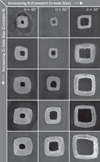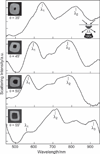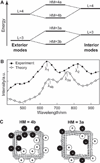Optical properties of tipless gold nanopyramids
- PMID: 21656907
- PMCID: PMC3632636
- DOI: 10.1002/smll.201100758
Optical properties of tipless gold nanopyramids
Figures





References
-
- Chamberlin DR, Wang Z, Sultana KA, Chow EK, Sigalas MM, Liu M, Grot AC, Fan S. Proc. SPIE. 2005;5927:592708.
- Sherry LJ, Chang S-H, Schatz GC, Van Duyne RP, Wiley BJ, Xia Y. Nano Lett. 2005;5:2034. - PubMed
- Haes AJ, Zou S, Schatz GC, Van Duyne RP. J. Phys. Chem. B. 2004;108:6961.
-
- Hu R, Yong K-T, Roy I, Ding H, He S, Prasad PN. J. Phys. Chem. C. 2009;113:2676. - PMC - PubMed
- Tong L, Wei Q, Wei A, Cheng J-X. Photochem. Photobiol. 2009;85:21. - PMC - PubMed
- Chen J, Saeki F, Wiley BJ, Cang H, Cobb MJ, Li Z-Y, Au L, Zhang H, Kimmey MB, Li Y, Xia Nano Lett. 2005;5:473. - PubMed
- Loo C, Hirsch L, Lee M-H, Chang E, West J, Halas N, Drezek R. Opt. Lett. 2005;30:1012. - PubMed
-
- Zhou F, Li Z-Y, Liu Y, Xia Y. J. Phys. Chem. C. 2008;112:20233.
- Lee J, Hasan W, Lee MH, Odom TW. Adv. Mater. 2007;19:4387.
- Wang H, Brandl DW, Nordlander P, Halas NJ. Acc. Chem. Res. 2006;40:53. - PubMed
- Shumaker-Parry JS, Rochholz H, Kreiter M. Adv. Mater. 2005;17:2131.
- Nicewarner-Peña SR, Freeman RG, Reiss BD, He L, Peña DJ, Walton ID, Cromer R, Keating CD, Natan MJ. Science. 2001;294:137. - PubMed
- Shuford KL, Lee J, Odom TW, Schatz GC. J. Phys. Chem. C. 2008;112:6662.
- Henzie J, Shuford KL, Kwak ES, Schatz GC, Odom TW. J. Phys. Chem. B. 2006;110:14028. - PubMed
-
- Gole A, Murphy CJ. Chem. Mater. 2004;16:3633.
- Zinchenko AA, Yoshikawa K, Baigl D. Adv. Mater. 2005;17:2820.
-
- Hao F, Nehl CL, Hafner JH, Nordlander P. Nano Lett. 2007;7:729. - PubMed
- Jana NR, Gearheart L, Murphy CJ. J. Phys. Chem. B. 2001;105:4065.
Publication types
MeSH terms
Substances
Grants and funding
LinkOut - more resources
Full Text Sources

